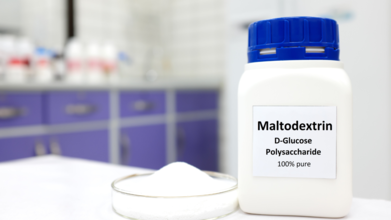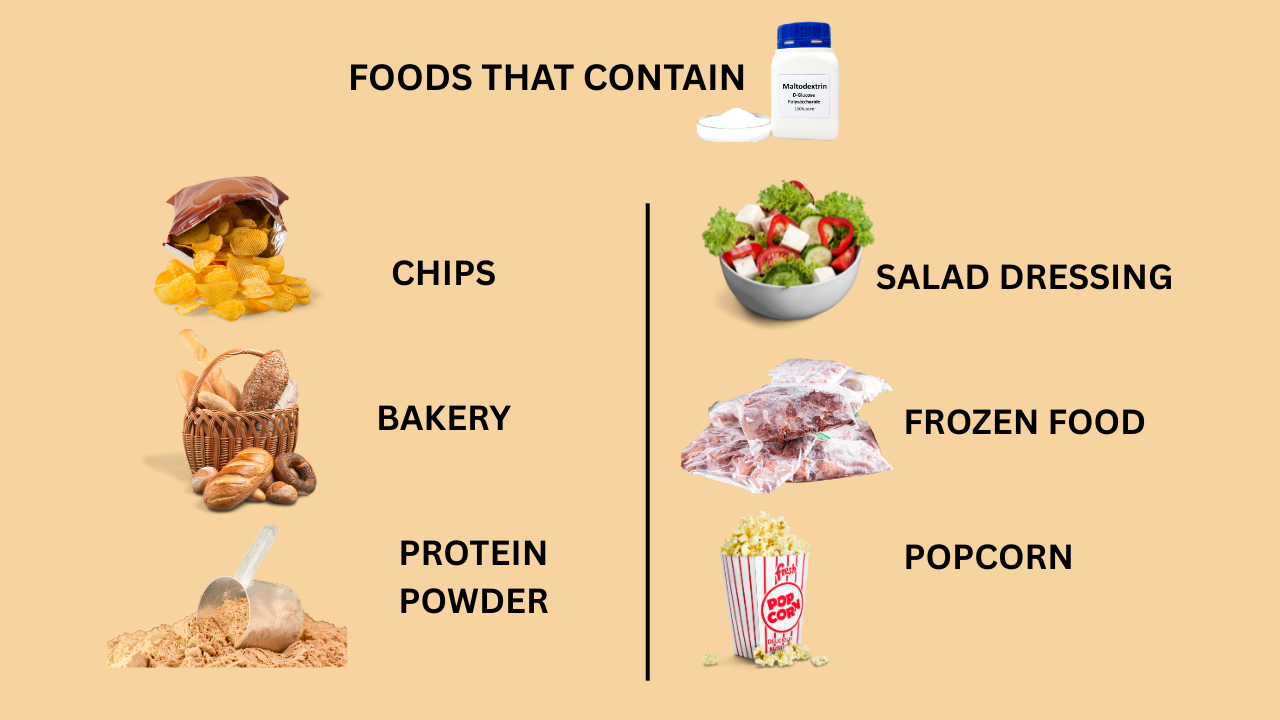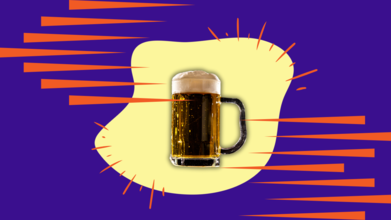- Health Conditions A-Z
- Health & Wellness
- Nutrition
- Fitness
- Health News
- Ayurveda
- Videos
- Medicine A-Z
- Parenting
- Web Stories
THIS Ingredient Is Even Worse Than Sugar, And You Are Consuming It Everyday

Credits: Canva
"Sugar has a bittersweet reputation when it comes to health," notes Harvard Health Publishing's piece on how too much sugar can lead to the greatest threats to cardiovascular disease. However, there exists something else that could be worse than sugar. Maltodextrin.
While part of a balanced diet, and it can provide carbohydrates and energy, especially those who need an instant increase in blood sugar levels, however, its consumption must be regulated and balanced with fiber and protein.
What Exactly Is Maltodextrin?
It is a white powder, which is made from corn, rice, potato starch, or wheat. While it is plant based, it is highly processed.
How is it extracted? The starch is first cooked and then is added with acids or enzymes like heat-stable bacterial alpha-amylase, which breaks it down further. As a result, a white powder, which is also water soluble, has a neutral taste, is created. If one has to draw a close parallel, it could be corn syrup solids. However, what makes it different from corn syrup solids is the sugar content.
Both of them undergo hydrolysis, which is a chemical process that involves addition of water to further help with the breakdown. As per the Handbook of Food Preservation, after hydrolysis, corn syrup solids are at least 20% sugar, while maltodextrin is less than 20% sugar.
What Makes It So Dangerous Then?
Dietician Lavleen Kaur, in her Instagram reel mentioned that maltodextrin is found in most processed foods. This means, if we are consuming processed food, we are continuously consuming maltodextrin, even if it has a low sugar percentage as compared to corn syrup, the frequency of the consumption could result in high blood sugar.
"This silent culprit, often found in processed foods, can spike your blood sugar levels even higher than table sugar. Prioritize your health by cutting down on ultra-processed foods and make informed choices," said Kaur.
Is It Safe To Consume?
As per the Food and Drug Administration (FDA), maltodextrin has been approved as a safe food additive. It is also included in the nutritional value of food as part of the total carbohydrate count.
The Dietary Guidelines for Americans suggest that carbohydrates must make up 45% to 65% of one's overall calories. Most of these must be complex carbohydrates, which are rich in fiber, rather than simple carbohydrates, which can raise blood sugar in a go.
Maltodextrin has a high glycemic index (GI) value, which means it can cause a spike in your blood sugar. However, only if consumed in small amounts, it is safe to use. If someone has diabetes, one should be mindful of how much they consume, and also speak to the doctor before making any change with their diets.
Why Is Maltodextrin Added In Foods?

The main purpose of this ingredient is to increase the volume and the solubility of the product. It also helps extend its shelf life. Furthermore, it increases sweetness, prevents melting and reduces nutrient losses.
Health Issues And Maltodextrin
Maltodextrin due to its high GI value, could be unsafe for those struggling with diabetes. Issues like inflammatory bowel diseases and ulcerative colitis, Crohn's disease, and an increased risk to infections like E.coli and Salmonella could be also linked to maltodextrin. The US FDA researchers found that it is because maltodextrin can alter gut bacteria, impair mucus release, and suppress the growth of good bacteria in gut.
High Diabetes Risk Or Low - How You Cook Your Potatoes Could Determine Your Diabetes Risk

(Credit-Canva)
If you are someone who is interested in fitness, healthy diets and exercising for your health, you may have heard various opinions about potatoes in the diet. While there are people who enjoy potatoes, and believe they are healthy, there are other people who do not believe so. Many people believe that the high amount of carbs in the food overburdens the entire meal.
However, new research shows that how you prepare your potatoes matter more, than eating the potatoes does.
Are You Cooking Your Potatoes Wrong?
Published in the BMJ, the study suggests that not all potatoes are created equal when it comes to the risk of type 2 diabetes. While regularly eating French fries was found to increase the risk, eating potatoes prepared in other ways—like mashed, baked, or boiled—did not.
The study also found that swapping any type of potato for whole grains could lower your chances of getting the disease. This is important because according to the CDC, about 38 million Americans have diabetes, and the vast majority have type 2.
How You Cook Potatoes Matters
For years, potatoes have had a bad reputation in the world of diabetes because they are high in carbs and can raise blood sugar levels quickly. However, this new research, published in The BMJ, looked at how different cooking methods change the health impact of potatoes.
Researchers followed more than 200,000 people for up to 36 years, tracking their diets and lifestyles. The results showed that having French fries just three times a week raised the risk of developing type 2 diabetes by 20%. On the other hand, eating baked, boiled, or mashed potatoes did not increase this risk.
The researchers says the problem with French fries is the way they're cooked. Frying potatoes in oil at very high temperatures adds a lot of fat and can create harmful compounds, which can lead to inflammation and increase the risk of type 2 diabetes.
In contrast, methods like baking and boiling don't add these unhealthy elements. Because of their beneficial nutrients like fiber and potassium, non-fried potatoes can actually be part of a healthy diet, even for those with diabetes.
What Are Some Healthy Potato Swaps?
The study also found that swapping out potatoes for whole grains had an even bigger positive effect. Replacing three servings of French fries per week with whole grains—like whole wheat pasta or farro—was estimated to lower the type 2 diabetes rate by 19%.
The reason for this, according to experts, is the fiber in whole grains. Fiber helps slow down how quickly your body absorbs sugar, which keeps your blood sugar levels more stable.
Simple Ways To Make Your Diet Healthier
Making small changes can have a big impact on your health. The National Institute of Diabetes and Digestive and Kidney Diseases recommends a few simple strategies to help prevent type 2 diabetes:
- Make healthier swaps when you can, such as choosing a baked potato instead of French fries.
- Drink water instead of sugary drinks like soda or juice.
- Choose smaller portions of foods that are high in calories, fat, and sugar.
- Eat foods with less trans fat, saturated fat, and added sugars.
- By making consistent, simple choices, you can make a real difference in your long-term health without giving up all your favorite foods.
What Happens To Your Body When You Drink Beer Every Night?

Credits: Canva
If your evening ritual involves cracking open a cold beer, you’re are part of a million people who do it without thinking twice but alcohol, even in small amounts, doesn’t come without strings attached. Sure, beer has been painted as the “safer” choice compared to spirits, but the truth is, it’s still alcohol. And alcohol changes the way your body works—from your brain chemistry to your liver function—whether you feel it right away or not. The question isn’t just “Does it feel relaxing?” but “What’s it really doing to you every single night?”
In the United States, over half of the total alcohol consumed is mandated by beer, based on a 2018 study in Nutrients. Whether it's a Friday afternoon round at the local pub or a daily habit, the beverage's popularity cannot be denied but here's the question that counts, what exactly happens to your body if you have a beer every night? The response isn't simple. Beer has possible benefits for some, but it's also associated with dangers that build upon frequency and volume. Let's get into it.
A typical 12-ounce beer has around 150 calories. That is, of course, if you opt for one with a moderate alcohol by volume (ABV). Bigger ABV beers—IPAs or stouts, for example—contain even more calories.
The body metabolizes alcohol differently than carbs, fats, or protein. With 7 calories per gram, alcohol falls between fat and carbohydrates in the calorie content. Over the long term, those additional calories do indeed add up.
Research in Current Obesity Reports (2015) reveals that moderate beer drinking doesn't have to lead to weight gain if you pair it with an active, balanced lifestyle. But push past moderation—say, two or three beers a night—and you could be adding 300+ calories daily. Add to that alcohol's tendency to stimulate appetite and dampen fullness signals, and you've got a recipe for overeating.
Your Kidneys Are Worked Harder
The kidneys are your body's filtering system, removing waste and maintaining fluid balance. Alcohol is a diuretic, leading to increased urine output and possibly taxing the function of the kidneys.
The National Kidney Foundation cautions that gradually, drinking heavily can elevate blood pressure, a leading risk factor for kidney disease. You may also lose electrolytes such as sodium and potassium more quickly than you can replenish them.
Interestingly, a 2016 Nutrients study found that non-alcoholic beer doesn’t have the same diuretic effect. So if you’re training for a long run or hitting the gym, swapping in an alcohol-free beer might spare your kidneys some strain.
Your Heart Could Benefit—or Be Harmed
When it comes to cardiovascular health, beer is a narrow line. Excessive drinking certainly increases the risk of hypertension, arrhythmias, stroke, and heart failure. The harm is both from daily patterns of drinking and bingeing, even if the weekly intake is the same.
But moderate consumption might have another tale to tell. Some studies suggest protective effects from the polyphenols in beer—plant chemicals that inhibit the oxidation of LDL cholesterol. This effect is seen in both alcoholic and non-alcoholic beer, which implies it's what's in the beer, and not only the alcohol, that is acting.
Nevertheless, the American Heart Association states flatly: alcohol should not be used as a preventive against heart disease. The possible benefit must be balanced against harm.
Your Brain Health Is a Mixed Bag
Alcohol acts on the brain in several different ways—both short-term and long-term.
A 2016 Current Alzheimer Research study that followed 360 older adults for 19 years found no link between moderate beer drinking and more rapid cognitive decline. On the contrary, beer with more hops may have neuroprotective effects due to substances that lower the brain's inflammatory responses.
On the other hand, the BMJ (2017) quoted that heavy drinking heightened the risk of dementia with no protective factor from light drinking. The bottom line? The jury's still out.
Your Sleep Quality May Suffer
Beer can make you sleepy to start with, but that doesn't equate to it making you sleep well. Booze interferes with the brain's communication system, affecting how you process information and how deeply you sleep.
A 2018 JMIR Mental Health review discovered light drinking cut sleep quality by more than 9%. Sure, it doesn't seem colossal, but the impacts add up in the long run—particularly if you use booze as a nightly terminator.
Your Weight-Loss Plans Might Stop Dead in Their Tracks
If you’re trying to lose weight, beer can slow your progress for one simple reason: your body prioritizes metabolizing alcohol over burning fat. While your liver processes the alcohol, fat burning takes a back seat.
Long-term, excessive intake can damage the liver to the point of permanent scarring (cirrhosis). Even before that stage, fatty liver disease can develop, disrupting metabolism further.
Your Gut Health Could Shift—For Better or Worse
Beer in excess levels inflames the lining of the intestines and shifts gut bacteria, possibly causing leaky gut syndrome. That opens the door for the body to become more susceptible to systemic inflammation and liver disease.
But since beer is a fermented drink, some research (such as a 2020 paper published in Molecules) indicates moderate consumption might enhance gut microbiota diversity. The advantage depends solely on maintaining consumption as moderate—cross that threshold and the cons tip the scale.
Beer’s diuretic effect can contribute to dehydration, particularly if you’re not drinking enough water alongside it. While beer is less dehydrating than liquor or wine in moderate amounts, it still challenges your body’s fluid regulation.
That dehydration can play a role in hangovers, fatigue, and impaired recovery from exercise. The fix is simple but often overlooked—water between beers.
Excessive alcohol consumption is cited by the CDC as a risk factor for various chronic conditions: hypertension, heart failure, stroke, and several cancers, including oral, pharyngeal, esophageal, liver, colon, and breast cancer.
Alcohol is responsible for 6% of all cancers and 4% of deaths from cancer in the United States, according to the American Cancer Society.
While certain studies suggest cardiovascular advantage from moderate drinking, the body of evidence as a whole indicates that there is no safe level of alcohol when it comes to cancer risk.
Chia Seeds Are A Great Source Of Nutrition, Expert Explains Why Eating Them 'Dry' Could Kill You

Credits: Health and me
Chia seeds have earned their place as a pantry staple for health-conscious eaters. From smoothie bowls to overnight puddings, these tiny black-and-white seeds have been celebrated for their rich nutrient profile and versatility but according to Dr. Kunal Sood, MD, a Maryland-based physician who shared his warning in an Instagram video, the way you consume chia seeds matters just as much as the fact that you’re eating them. In some cases, eating them the wrong way could even be life-threatening.
Native to Central America, chia seeds have been part of human diets for centuries, once prized by the Aztecs and Mayans for their stamina-boosting properties. Modern nutrition science has confirmed what ancient cultures already knew, chia seeds are incredibly nutrient-dense. Just an ounce of chia seeds has about 10 grams of fiber, 5 grams of plant-based protein, and a high dose of omega-3 fatty acids. They’re also packed with antioxidants, calcium, magnesium, and phosphorus.
These nutrients work together to support heart health, improve digestion, aid weight management, and even help stabilize blood sugar. The seeds’ high soluble fiber content can slow digestion, keeping you full longer and helping regulate cholesterol levels but as Dr. Sood points out, the same qualities that make chia seeds beneficial can also create risks if they’re consumed improperly.
One of chia seeds’ most unique properties is their ability to absorb liquid. When placed in water or another liquid, they can expand to up to 12 times their original size, forming a gel-like coating. This is the magic behind chia pudding and the reason why chia seeds are a go-to thickener in vegan recipes.
However, this expansion ability isn’t just a kitchen trick, it also happens inside the body. If the seeds are eaten dry and then encounter moisture in the throat or digestive tract, they can quickly swell, potentially creating a blockage.
Dr. Sood warns, “Chia seeds absorb a lot of liquid — sometimes up to 12 times their weight. That’s why you should never eat them dry and immediately chase them with water. They can expand before reaching the stomach and get stuck, especially if they clump together.”
In his video, Dr. Sood referenced a rare but alarming case of a 39-year-old man who swallowed a tablespoon of dry chia seeds, followed by a glass of water. Instead of passing smoothly into the stomach, the seeds expanded and gelled together in his esophagus, blocking his airway. Emergency medical intervention was required to clear the obstruction.
While such cases are uncommon, they illustrate the importance of understanding how chia seeds behave once ingested — and why preparation matters.
Why Soaking Chia Seeds Makes Them Safer?
Soaking chia seeds before consumption not only prevents dangerous blockages, but it also enhances their digestibility. When seeds are pre-hydrated in water, milk, or juice for about 10–15 minutes, they fully expand outside of the body. This means they arrive in your stomach already in their gel form, reducing any risk of swelling mid-swallow.
Pre-soaking also starts to break down the seeds’ outer shell, making it easier for your body to access their nutrients. The gel-like texture they form slows down carbohydrate absorption, which can help keep blood sugar levels steady.
Best Way To Eat Chia Seeds
For most healthy adults, chia seeds are perfectly safe when prepared properly. Dr. Sood recommends starting with small amounts — a teaspoon or two — especially if you’re not used to a high-fiber diet. Too much too soon can lead to bloating, gas, or constipation, because chia seeds absorb moisture from your digestive tract.
Hydrate. If you blend chia seeds into smoothies, oatmeal, or yogurt, ensure that there's sufficient liquid for them to soak up. If you're including them in baked foods, the moisture in the batter is often enough, but you must drink plenty of water during the day.
Individuals with certain medical conditions — including swallowing disorders, narrowing of the gastrointestinal tract, or a history of esophageal strictures — ought to be particularly careful and consult their physician prior to incorporating chia seeds into their nutrition.
How To Add Chia Seeds in Everyday Eating?
After being soaked the right way, chia seeds can be incorporated into endless dishes. Some of the most popular include:
- Overnight almond milk chia pudding with fresh fruit
- Blended with smoothies for added nutrition and thickness
- Topped on yogurt or oatmeal
- Added to salad dressings as a natural thickener
- Baked in vegan recipes as an egg substitute (1 tablespoon chia seeds + 3 tablespoons water = 1 "egg")
Since they're almost flavorless, chia seeds lend themselves to both sweet and savory recipes.
Chia seeds are a nutritional powerhouse, delivering a concentrated amount of fiber, healthy fats, protein, and antioxidants in an extremely small package but as Dr. Sood’s warning makes clear, their super-absorbent nature means they must be handled with care.
Never eat large spoonfuls of dry chia seeds and wash them down with liquid. Instead, soak them first to prevent dangerous swelling in the throat or esophagus. Pairing chia consumption with adequate hydration will not only keep you safe, but also maximize the seeds’ digestive and nutritional benefits.
With chia seeds, it’s not just what you eat it’s how you eat it. Prepared properly, they can be a safe, delicious, and versatile addition to your diet. Handled carelessly, they can pose risks that are entirely avoidable.
© 2024 Bennett, Coleman & Company Limited

